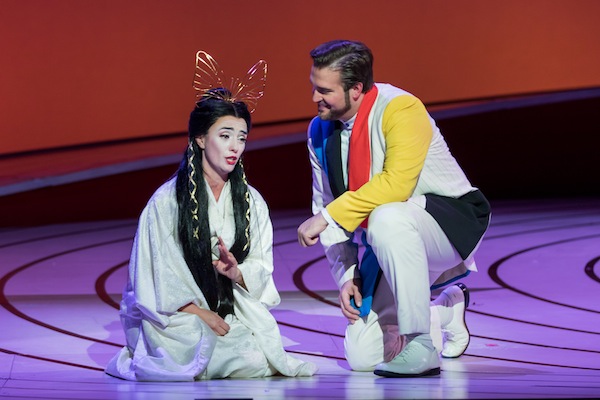Washington National Opera’s “Butterfly” fails to take wing

Ermonela Jaho and Brian Jagde in Puccini’s “Madama Butterfly” at Washington National Opera, Photo: Scott Suchman
Faced with the failure of his opera Madama Butterfly at its premiere in 1904, Giacomo Puccini worried to a friend that the Italian public had tired of “mia musica zuccherata” (my sugared music). Once he had worked out the kinks from the first performances, however, the opera became a perennial favorite.
Washington National Opera’s current production, which opened on Saturday night at the Kennedy Center Opera House, is the company’s fourth in the last two decades. In a run with fourteen scheduled performances, that is a lot of Butterfly.
The success of any production depends almost entirely on the casting of the title role. Puccini and his librettists arranged most of the drama to focus on the intense suffering of the heroine. If the soprano has the vocal goods and can act in a convincing way, those expected Puccini shivers, the thrilling horripilations induced by Butterfly’s exquisite anguish, are assured.
In a cruel twist WNO lost its scheduled Butterfly Hei-Kyung Hong, who withdrew from the production in early April. The company engaged a team of sopranos to cover the long run, beginning with Ermonela Jaho, who made her company debut on opening night. The Albanian soprano has garnered critical acclaim in her performances of this role in London and elsewhere. Expectations ran high, only to be dashed last night.
Jaho acted the part admirably, creating a Butterfly both coy and girlish. Her gestures, tilts of the head and placement of the hands in stylized patterns, seemed to recall those of the life-like marionettes of the Bunraku theater in Japan (direction by Leslie Swackhamer). Jaho’s pianissimo singing was almost inaudibly soft, a sighing exhalation that was quite lovely.
However, the major climaxes of the opera, powered almost exclusively by the soprano voice, all fell short. In addition to her light tone, Jaho’s voice sometimes skewed out of tune or became shrill. Hers was a Butterfly performance that was visually believable, but musically jejune.
This shortcoming was all the more apparent because her Pinkerton, tenor Brian Jagde, had all of the heroic vocal presence she lacked. In an impressive WNO debut, Jagde’s clarion top range rang out with ease and confidence, filling the large hall. His Pinkerton was all enthusiasm, full of frat-boy swagger and back-slapping vigor, and the power of his voice became a symbol of the brashness and insensitivity of the ugly American abroad.
Jagde stood head and shoulders, musically and literally, above the rest of the cast, entirely overshadowing the demure Suzuki of Kristen Choi and the pale Sharpless of Troy Cook in their Act III trio. Choi was too light vocally as Suzuki, her part in the Flower Duet almost vanishing, and, likewise, Cook did not have enough volume to serve as Pinkerton’s outraged moral conscience.
Ian McEuen was a soft-voiced Goro, in a characterization of smarmy gestures. Some members of the Domingo-Cafritz Young Artist Program stood out for praise, especially the menacing Bonze of Timothy J. Bruno. As the spurned suitor Yamadori, baritone Michael Adams was so strong of voice that he may have been a better choice for the role of Sharpless.
Music director Philippe Auguin’s leadership in the pit was again one of the highlights of this production, as it was for the last WNO Butterfly in 2011. When a conductor knows the score this well and can negotiate all of its twists and turns of rubato, accommodating both singers and players, the music flows in the best way possible. All of the musicians in the orchestra sounded supremely confident and in good form, in a score that is mostly exotic tinges and unison melodies, with a couple of powerful brass-powered crescendos.
Abstract artist Jun Kaneko took much the same approach to this opera as he did for his Magic Flute, seen in Washington in 2014. The same brightly colored patterns of lines and figural shapes seen in Kaneko’s sculpture, on exhibit in the Kennedy Center’s Hall of Nations, pervaded the set design and costumes. At crucial musical interludes, screens descended to show a gently undulating abstraction that glowed along with the shifting lighting (designed by Gary Marder).
The most curious aspect of the staging involved four supernumerary figures, not credited in the program. Costumed in black, including boxy veils that covered their faces, they were on the stage at the beginning of both Acts I and II, moving props into the singers’ hands and seeming in some ways to guide the action. They definitely seemed more than just stage crew, perhaps shadows or spirits of some sort, especially when they brought in the ceremonial sword of Butterfly’s father. By the end of the evening their role became clear. Their distinctive costumes seemed most like those worn by the puppeteers in the Bunraku theater, making the characters like marionettes.
Madama Butterfly runs through May 21, with four different casts. kennedy-center.org; 202-467-4600.


